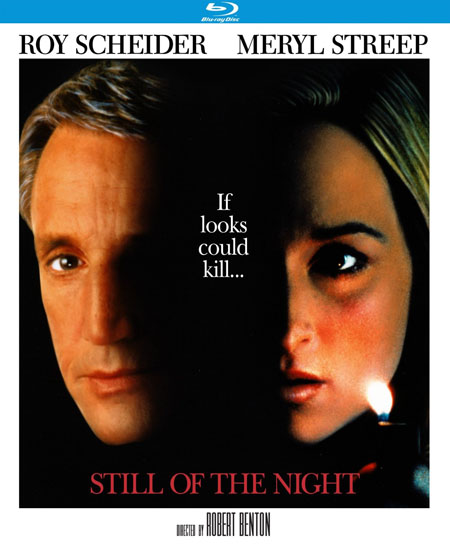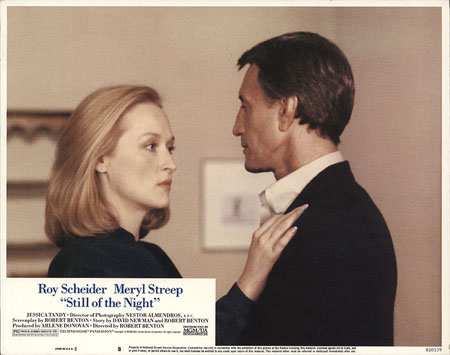
BY LEE PFEIFFER
In the 1970s and 1980s director Brian De Palma had some high profile hits with Hitchcockian thrillers such as "Sisters", "Obsession", "Dressed to Kill", "Blow Out" and "Body Double". De Palma's defenders extolled the virtues of these films as clever homages to Hitchcock while detractors accused De Palma of using The Master's formulas to make a fast buck. In 1982 director Robert Benton jumped on the same bandwagon with his own Hitchcockian project, "Still of the Night", which was shot under the title "Stab" before the marketing campaign had been re-evaluated. A few years earlier Benton had triumphed at the Oscars with "Kramer vs. Kramer", taking home the Best Director Oscar. That film also provided an important career boost for Meryl Streep, who also won an Oscar for Best Supporting Actress. The two were reunited for this project which stands out on both of their credentials as an odd choice. Chances are that when you think of Streep's exalted status in the film community today, the thriller genre is unlikely to come to mind. (Though she did also appear in "The River Wild" and the remake of "The Manchurian Candidate".) Benton, who had directed relatively few films to date, was more accustomed to the genre and perhaps his involvement with this flawed production can be explained by the fact that the basis for the story (which he collaborated on with David Newman) was a real life experience that found him obsessed with a woman who simultaneously excited and frightened him. Certainly it's a sold premise for a thriller and through much of the movie Benton provides a compelling scenario complimented by two excellent actors: Streep and Roy Scheider. The film falls apart in the final act when it begins to resemble less of a homage to Hitchcock than an homage to De Palma's homages to Hitchcock- with a dose of "Play Misty for Me" thrown in (i.e knife wielding killer attacks protagonist on a balcony that overlooks the churning sea.) It's not that "Still of the Night" is bad (though Streep has gone on record as saying it is), it's simply that it hardly seems like it would ever have been compelling enough to attract two recent Oscar winners.
The film opens in the office of New York City psychiatrist Sam Rice (Scheider). Like most cinematic headshrinkers, he appears to need psychiatric care more than his patients do. He's going through the miseries of a divorce and seems bored and depressed. The only significant female relationship he has is with his mother (Jessica Tandy, who perhaps not coincidentally starred in Hitchcock's "The Birds".) Sam's mundane daily routine takes a dramatic turn when he discovers that a long-time patient, businessman George Bynum (Josef Sommer) has been found stabbed to death in his car on a Manhattan street. From this point some key elements of the story are told in flashback sequences. Sam remembers Bynum as a sexual predator who had been having an affair with one of his staff workers. Then he meets Brooke Reynolds (Streep), a gorgeous thirty-something blonde who seems both alluring and vulnerable. Bynum confesses that he is obsessed with her and cut off his previous affair in order to engage in one with Brooke. Shortly after Bynum's death, Sam is shocked when Brooke appears at his office, nervous, unsettled and chain-smoking. (Yes, you could smoke in an office in those days.) In the awkward conversation that follows she says the purpose of her visit is to return a wristwatch that Bynum had accidentally left at her apartment. She doesn't want to return it herself for fear of alerting Bynum's widow about the affair he was having with her. From minute one Sam is smitten and intrigued by this quirky, jittery- and stunningly beautiful- young woman. He also realizes that her cover story about the watch is thin. She actually wanted to meet him. Shortly thereafter Sam is visited by Detective Joe Vitucci (Joe Grifasi, channeling every personality cliche you can think of when it comes to a New York City cop). He asks Sam if he can shed any light on who might be Bynum's killer. Sam informs him that anything he had discussed with Bynum would be protected under doctor/client privilege...but he also finds himself unable to inform Vitucci about Bynum's affair with Brooke. He realizes he is now obsessed with her, just as Bynum was. He strongly suspects that Brooke is Bynum's murderer but can't get her out of his mind. Like Bynum, he's simultaneously sexually stimulated and terrified of her. Nevertheless, he begins finding excuses to see her and his presence seems to have a calming effect on Brooke. The friendship goes to another stage when she responds to his kiss but Sam is too lacking in self-confidence to actually seduce her. Meanwhile he begins to experience some eerie occurrences. He believes someone is stalking him in the basement of his apartment building. As he follows the mysterious Brooke on a nighttime walk through Central Park (a chilling scenario for anyone in those days), he finds himself alone and so unnerved that when a man jumps out of the shadows to mug him, he is actually relieved to have another human being on the scene. Director Benton knows that a sure-fire way to ratchet up suspense is to put the protagonist in a creepy dark house or in an equally unnerving location. However he goes to the well with this plot device a little too often. For a man who lives in the heart of Manhattan, Sam seems to wind up repeatedly in eerie, isolated places. However, some of the sequences are genuinely suspenseful as in the scene in which Sam is in the laundry room of his apartment building, deep in the bowels of the basement. No one is around. There is total isolation when suddenly the lights in an adjoining room inexplicably go out. You can share his sense of increasing panic as he knows someone is stalking him...but who and why? Refrehingly, Scheider portrays Sam as an everyday guy, not a tough-as-nails hero. He's vulnerable both physically and emotionally throughout.

The film's primary asset is its two stars, both of whom give intense and very convincing performances. There are also the usual plot twists and red herrings one would expect to find in a movie of this genre and Benton for the most part manages to wring some genuine suspense out of it even when he resorts to old gimmicks that include a dream sequence in which Bynum is menaced by an eerie little girl (are there any other kinds of little girls in dream sequences?) It's straight out of "The Shining" but then again just about everything in "Still of the Night" seems recycled, even though it manages to be engrossing right up until the climax when Benton the screenwriter resorts to every time-worn cliche imaginable: an old dark house, a sacrificial lamb character, a vulnerable hero, a knife-wielding maniac...you get the picture. About all that is missing is John Carradine as a mad scientist. The weak ending feels like it was tossed together at the last minute and doesn't retain the suspense or logic that Benton has managed to build heretofore. Nonetheless, "Still of the Night" is still worth a look if only for the performances and those few genuinely spooky sequences.
The Blu-ray edition from Kino Lorber includes the original trailer and trailers for two other Roy Scheider films, "Last Embrace" and "52 Pick-Up."
CLICK HERE TO ORDER FROM AMAZON